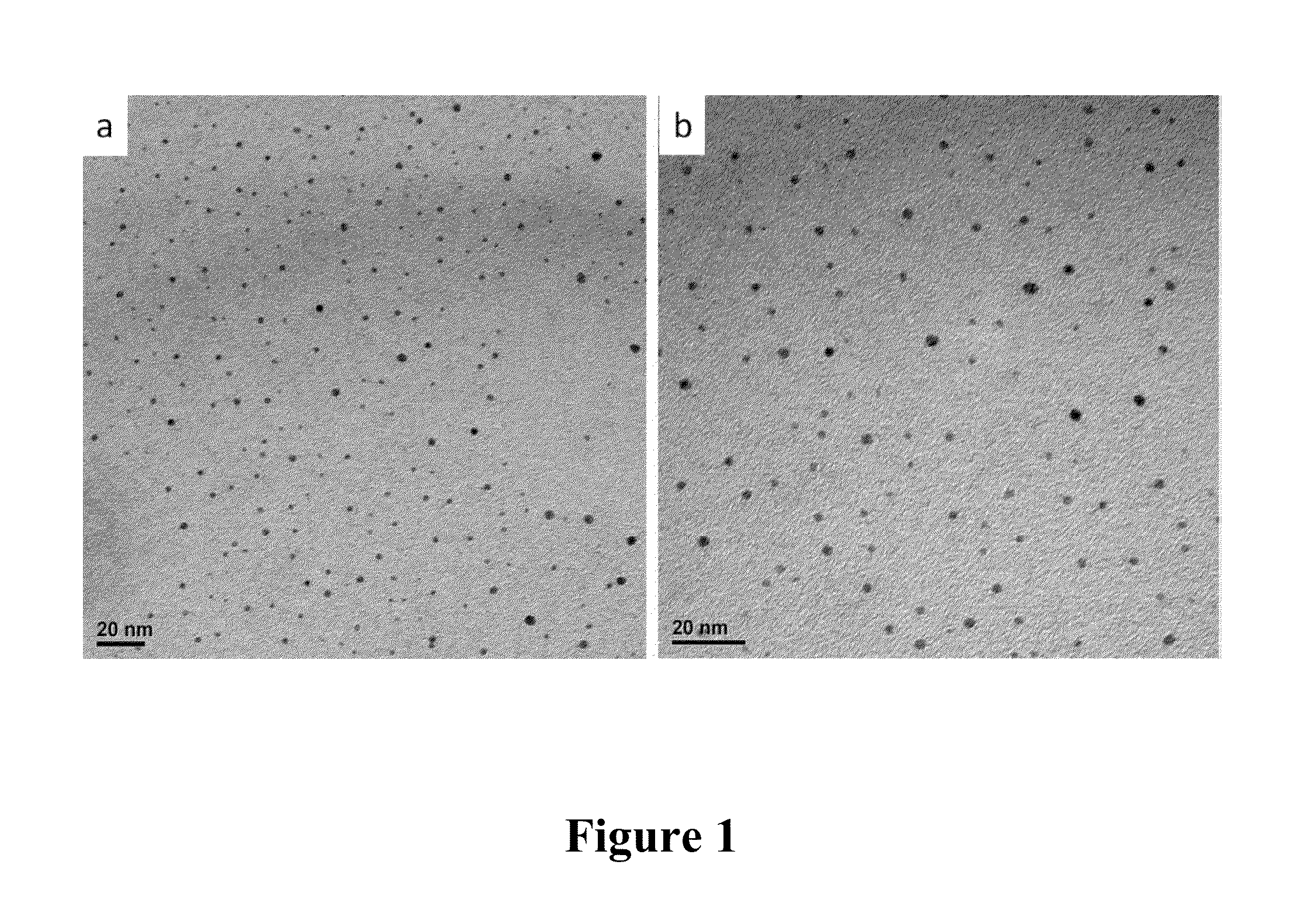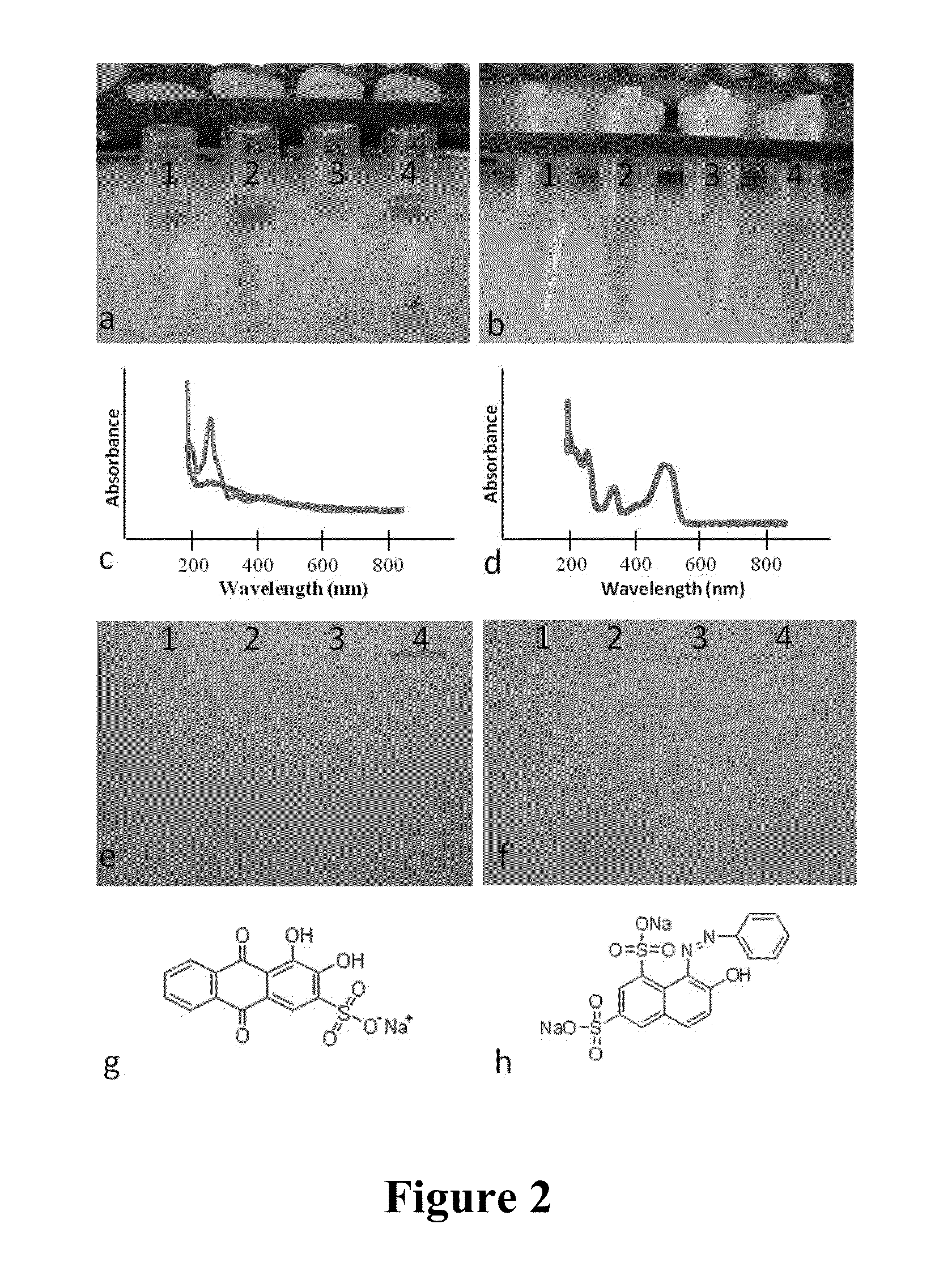Multifunctional nanoconjugates and uses thereof
- Summary
- Abstract
- Description
- Claims
- Application Information
AI Technical Summary
Benefits of technology
Problems solved by technology
Method used
Image
Examples
example 1
Core Nanoparticle Preparation
[0076]For the synthesis of 6 nm TiO2 nanoparticles, TiCl4 was used as the reaction agent, and cetyltrimethyl ammonium bromide (CTAB) was used as the dispersant (see, e.g., Aiguo Wu, et al., Nano. 2008, 3 (1): 27-36, hereby incorporated by reference in its entirety). All agents were purchased from Guoyao Ltd (China) as analytical pure grade and deionized water was used as solvent. Before the experiment, 0.1 M TiCl4 in 20% HCl solution was first prepared and stored at −20° C. The synthesis of TiO2 nanoparticles was carried out using a magnetic stirrer and the reaction temperature was about 4° C., which was controlled in an ice bath. First, 10 mL of 0.1 M TiCl4 solution was gradually dropped into 200 mL of deionized water under vigorous stirring, and the reaction was maintained for approximately 4 h. Then 10 mL of 0.5 mM CTAB was dropped into the solution, and the solution was continuously stirred magnetically for approximately 1 h. Finally, the product was...
example 2
Assessing Dye Coating of Nanoparticles
[0077]Six nanometer TiO2 nanoparticles were synthesized and characterized through the methods described above. The interaction of two dyes, ARS (Sigma, St. Louis, Mo., USA) and orange G (Sigma), with TiO2 nanoparticles was investigated through four different methods: sedimentation, spectral light absorbance, spectral fluorescence emission, and polyacrylamide gel electrophoresis. Sedimentation assays were performed by incubating each respective dye and TiO2 nanoparticles, centrifuging samples at 0.2 g for 3 min, then imaging with a Canon Powershot 7.1 Megapixel A620 digital camera. Shifts in spectral light absorbance and spectral fluorescence emission between dyes and dye-coated TiO2 nanoparticle samples were measured with a NanoDrop 2000 UV-Vis spectrophotometer as described previously [7] and NanoDrop 3300 Fluorospectrometer, respectively (Thermo Fisher Scientific, Waltham, Mass., USA). Stability between dye-TiO2 nanoconjugates was assessed by ...
example 3
Visible Light Activated ARS-Coated TiO2 Nanoparticles Degrade Plasmid DNA
[0081]The effect of visible light activated ARS-coated TiO2 nanoparticles was assessed by illuminating plasmid containing samples with a Fiber-Lite MI-150High Intensity Fiber Optic EKE 150 W21VHalogen Light Illuminator (Dolan-Jenner Industries, Boxborough, Mass., USA) for 10 min. The effect of UV light on activated ARS-coated TiO2 nanoparticles was assessed by illuminating plasmid containing samples with a 390 nm 13 W UV light source (Bayco, Wylie, Tex., USA). All samples were then run on a 1.25% agarose gel at 60V for 4 h, stained with GelStar (Lonza, Mapleton, Ill., USA), and imaged on a Kodak Gel Logic 2200 Imaging System (Kodak, Rochester, N.Y., USA).
[0082]As stated previously, it has been shown that dyes in general and ARS / TiO2 dispersions in particular are capable of releasing reactive oxygen species upon photoactivation by visible light [12,13]. Additionally, the DNA phosphate backbone has affinity for T...
PUM
| Property | Measurement | Unit |
|---|---|---|
| Diameter | aaaaa | aaaaa |
| Diameter | aaaaa | aaaaa |
| Absorbance | aaaaa | aaaaa |
Abstract
Description
Claims
Application Information
 Login to View More
Login to View More - R&D
- Intellectual Property
- Life Sciences
- Materials
- Tech Scout
- Unparalleled Data Quality
- Higher Quality Content
- 60% Fewer Hallucinations
Browse by: Latest US Patents, China's latest patents, Technical Efficacy Thesaurus, Application Domain, Technology Topic, Popular Technical Reports.
© 2025 PatSnap. All rights reserved.Legal|Privacy policy|Modern Slavery Act Transparency Statement|Sitemap|About US| Contact US: help@patsnap.com



